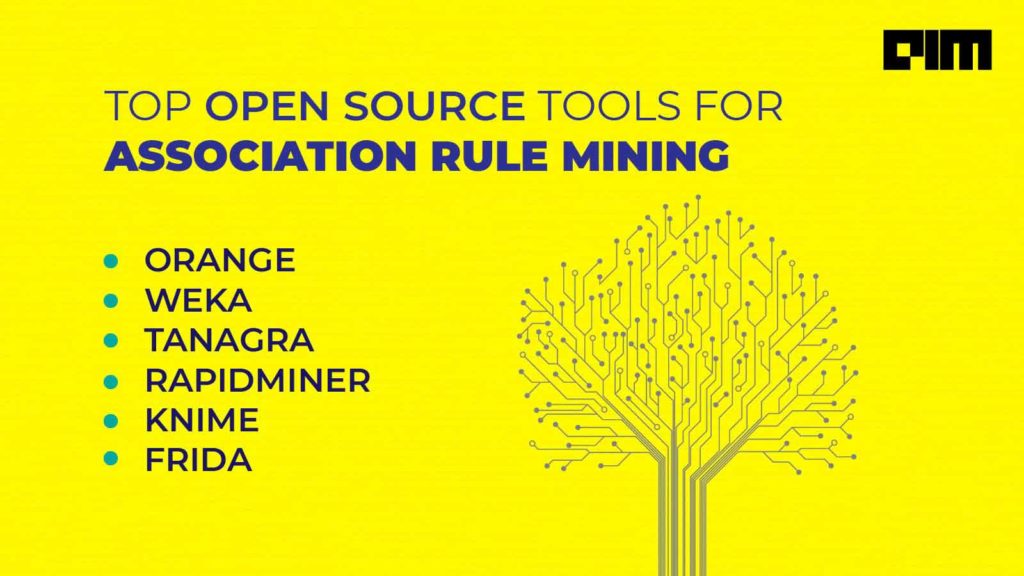One of the critical aspects of machine learning technique is data mining, where patterns in large data sets are discovered using statistics and database systems. However, identifying patterns in a large data set can be a challenging task; thus, association rule mining comes handy.
While most machine learning algorithms work on numeric data, association rule mining is apt for non-numeric categorical datasets. It is a process of observing patterns and correlations, aka associations from datasets that are frequently occurring in various databases such as transactional databases, relational databases, and other.
In this article, we list down, in alphabetical order, six best open-source association rule mining tools one must know.
Also Read: Understanding Association Rule Learning & Its Role In Data Mining
Orange
About: Orange is an open-source, component-based data mining tool used specifically for data visualisation and analysis. Written in Python, Orange includes a wide range of data visualisation, exploration, preprocessing and modelling techniques. To leverage association rule mining in Orange, one needs to select the add on to install “Associate.” Along with association rule mining, these add-ons will allow performing NLP, text mining as well as to conduct network analysis.
Some of the features are-
- Interactive data visualisation
- Interactive data exploration
- Visual programming
- User friendly
- Add-ons functionality
Know more here.
Weka
About: Waikato Environment for Knowledge Analysis, or as we know it — WEKA is another open-source machine learning tool that can be used for association rule mining. It can be accessed via a graphical user interface or standard terminal applications. Alongside, it can also be accessed through a Java API and can be used for preprocessing data implementation of ML algorithm, and data visualisation for any platform. WEKA consists of various ML algorithms that can be leveraged for solving real-world data mining problems.
Some of the features are-
- Gives transparent access to scikit-learn, R, and Deeplearning4j
- Encompasses built-in tools for basic ML tasks
- Preferred for teaching, research, and industrial applications.
Know more here.
Tanagra
About: Another open-source data mining tool for academic and research purposes is the Tanagra tool. It not only helps in association rule mining but also includes factorial analysis, clustering, parametric and non-parametric statistics etc. From exploratory data analysis to machine learning, this tool is capable of performing several data mining methods. One can access the source code and add his own algorithm to use Tanagra.
Some of the features are-
- Ability to analyse real as well as synthetic data
- Researchers can add their own data mining method and compare performances
- It includes a comprehensive set of data sources; direct access to databases; data cleansing; interactive utilisation
Know more here
Also Read: Best Open-Source Tools for Data Mining
RapidMiner
About: Developed by the company of the same name — RapidMiner is another open-source tool renowned for its easy to use visual environment for predictive analytics. It allows the user to connect to any data source whether it be enterprise data warehouses, data ages, cloud storages, business applications and social media. Along with that, RapidMiner comes with automated in-database processing where it runs data prep and ETL inside databases to optimise the data for analysis.
Some of the features are-
- Rich library of 1500 algorithms
- Automate the creation of predictive models
- Pre-built templates for everyday use cases
- Connect to any data source
Know more here
KNIME
About: Another open-source tool used for data analytics, reporting, and integration is KNIME. Written in Java and based on Eclipse, KNIME integrates various components of machine learning and data mining. This intuitive analytical platform supports many languages and comprises an integrated development environment and an extensible plug-in system. Not only can it be used for building machine learning models and optimise its performance, but also validate models, explain ML models and make predictions.
Some of the features are-
- Encompasses over 2,500 nodes to build the workflow
- Easy drag and drop style graphical interface
- Hundreds of publicly available workflows
Know more here
FRIDA
About: Lastly, FrIDA, an open-source tool for developers, reverse engineers and security researchers that allow them to process data. Written in C, FrIDA enables users to integrate snippets of JavaScript on the library into native apps on Windows, macOS, iOS, Android etc. Users can use the tools directly from C along with multiple language bindings — Node.js, Python, Swift, .NET, Qml etc.
Some of the features are-
- Can be used for API tracing
- Can be used to build application-specific tools with a few lines of Python.
- Can manipulate function calls to fake network conditions.
Know more here.





















